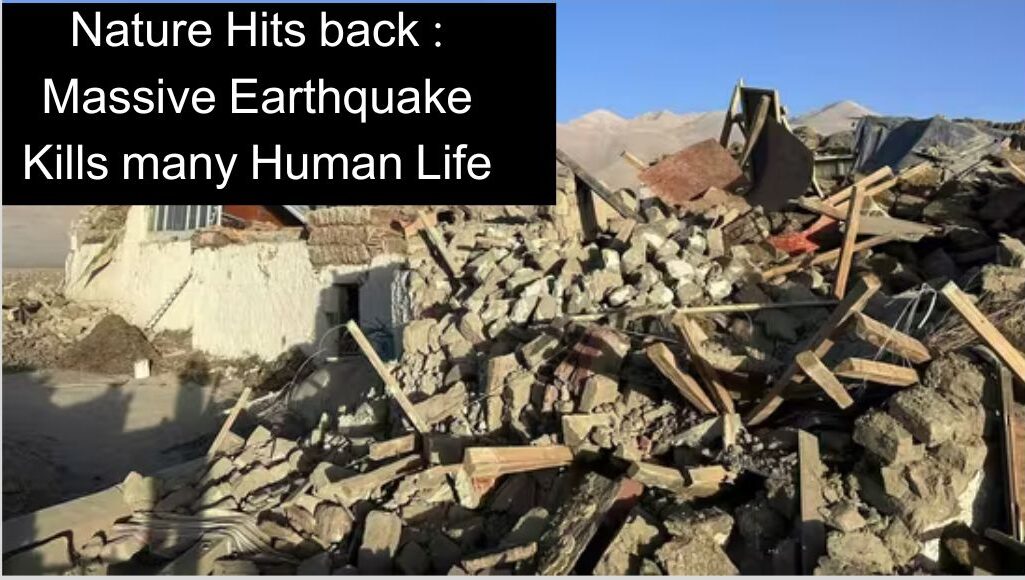On Tuesday, January 7, 2025, a powerful earthquake struck near Mt Kailash, killing at least 53 people and trapping many more as dozens of aftershocks rocked the western Chinese territory and Nepal across the border. Parts of India and Kathmandu, the capital of neighboring Nepal, were also affected by the tremors.
Earthquake : A Comprehensive Overview
Yesterday’s earthquake left a profound impact, shaking not only the ground beneath us but also our collective consciousness. It was a stark reminder of the power of natural forces and the importance of disaster preparedness. This article explores the event in detail, including its causes, effects, and the lessons we can learn to mitigate future risks.
What Happened Yesterday?
Yesterday, an earthquake of magnitude 7.2 struck near Mt. Kailsh range at early morning. The epicenter was located at Tingri (a village within Everest region), and the tremors were felt as far as neighboring country like Bharat, Nepal and China. This seismic event caused significant structural damage and disrupted the lives of thousands.
Residents described hearing a low rumble moments before the ground started to shake violently. Buildings swayed, items fell from shelves, and panic ensued as people sought safety. Emergency services were immediately deployed, working tirelessly to rescue those trapped and provide aid to affected areas.
Geographical Context
The affected region lies along the [Insert Fault Line], one of the most active seismic zones globally. This area has a long history of earthquakes due to its position near tectonic plate boundaries. Past events, such as [Insert Historical Earthquake], have shown the region’s vulnerability to high-magnitude tremors.
Seismologists have been closely monitoring the area, noting that the collision of Tectonic Plates has increased stress along the fault line. This stress eventually caused yesterday’s quake, releasing immense energy in a matter of seconds.
Causes of the Earthquake
The primary cause of yesterday’s earthquake was the movement of tectonic plates beneath the Earth’s crust. When plates collide, slide past, or move away from each other, they create pressure. Once this pressure exceeds the strength of the rocks holding them together, it triggers an earthquake.
In this case, the Specific Tectonic Movement played a critical role. Additional factors, such as geological conditions, also influenced the intensity and duration of the tremors. Understanding these causes is essential for improving predictive models and preparing for future seismic events.
Impact on People and Infrastructure
The earthquake caused widespread destruction across [Insert Regions]. Homes, schools, and businesses bore the brunt of the tremors, with several buildings collapsing. Infrastructure such as roads, bridges, and utilities was severely damaged, disrupting transportation and communication networks.
Tragically, the event also resulted in casualties and injuries. Emergency responders worked around the clock to rescue survivors and provide medical assistance. The emotional toll on residents cannot be overstated, as many lost loved ones, homes, and livelihoods.
Social and Economic Consequences
The social and economic repercussions of yesterday’s earthquake are far-reaching. Communities have been displaced, with thousands seeking shelter in temporary camps. Local businesses have suffered significant losses due to property damage and interruptions in operations.
Economically, the cost of rebuilding and recovery is expected to run into millions, if not billions, of dollars. Governments and aid organizations are already mobilizing resources to assist in the recovery process, but the journey to normalcy will be long and challenging.
Stories of Survival and Resilience
Amidst the chaos, stories of survival and resilience have emerged. In one instance, rescuers pulled a family of four from the rubble of their home after being trapped for hours. Their story highlights the bravery of emergency responders and the unyielding human spirit.
Local communities have also rallied together, providing food, shelter, and emotional support to those in need. Such acts of kindness and solidarity remind us of the strength we can find in unity during times of crisis.
Immediate Emergency Measures
In the wake of the earthquake, local governments and NGOs quickly activated emergency response plans. Search and rescue teams were deployed to the hardest-hit areas, while medical personnel set up temporary clinics to treat the injured.
International aid has also begun to pour in, with neighboring countries sending supplies, financial assistance, and specialized teams. These efforts are crucial in stabilizing the situation and laying the groundwork for recovery.
Also Read : HMPV Symptoms and how to survive | HMPV Outbreak scare the world
Preparedness and Mitigation
This disaster underscores the importance of preparedness and mitigation. Strengthening building codes, conducting regular earthquake drills, and educating the public about safety measures can significantly reduce the impact of such events.
Advancements in early warning systems have shown promise in providing critical seconds of notice before a quake strikes. These systems rely on seismic sensors and advanced algorithms to detect initial tremors and alert communities in real-time.
Role of Technology in Disaster Management
Technology plays a pivotal role in managing disasters like earthquakes. Real-time monitoring systems, such as [Insert System Name], help detect seismic activity and provide valuable data to researchers and emergency responders.
Additionally, tools like drones and satellite imaging are being used to assess damage and identify areas in need of immediate assistance. Communication apps and platforms have also proven invaluable in coordinating relief efforts and keeping the public informed.
Environmental Implications
Earthquakes can significantly alter the natural landscape. Yesterday’s quake caused visible fissures in the ground, landslides in hilly regions, and changes to river courses. These environmental impacts could have long-term effects on local ecosystems.
Aftershocks are another concern, as they can cause further damage and complicate recovery efforts. Experts are urging caution and advising residents to remain vigilant in the coming days.
Lessons Learned
Every disaster provides valuable lessons for the future. Yesterday’s earthquake exposed gaps in infrastructure resilience and emergency response capabilities. However, it also highlighted the effectiveness of certain measures, such as community-led rescue efforts.
Moving forward, governments and organizations must invest in disaster preparedness, improve urban planning, and foster international collaboration to minimize the impact of future earthquakes.
Comparing with Past Earthquakes
When compared to past events like [Insert Historical Earthquake], yesterday’s quake stands out due to [Insert Unique Factors]. While the magnitude may have been similar, differences in population density, infrastructure quality, and response times significantly influenced the outcomes.
Analyzing these differences can help researchers and policymakers develop more effective strategies for managing future seismic events.
FAQs about Earthquakes
- What causes earthquakes?
Earthquakes are caused by the movement of tectonic plates. When plates collide, separate, or slide past each other, they generate seismic energy. - How are earthquakes measured?
Seismologists use tools like the Richter scale or moment magnitude scale (Mw) to quantify the energy released during an earthquake. - What is the safest place during an earthquake?
The safest place is under sturdy furniture or against an interior wall. Avoid windows and heavy objects. - What is the Richter scale?
The Richter scale measures the amplitude of seismic waves, providing a numerical estimate of an earthquake’s strength. - Can earthquakes be predicted?
Currently, precise earthquake prediction is not possible. However, scientists can identify high-risk areas based on geological data. - What to do if you’re caught in an earthquake?
Drop, Cover, and Hold On! Stay indoors if possible, and move to an open area if outdoors. Avoid elevators and unstable structures.
Conclusion: Moving Forward Together
Yesterday’s earthquake was a harsh reminder of nature’s power, but it also showcased humanity’s resilience and capacity for solidarity. By learning from this event and investing in preparedness, we can reduce the impact of future disasters. Together, we can build a safer, more resilient world.


